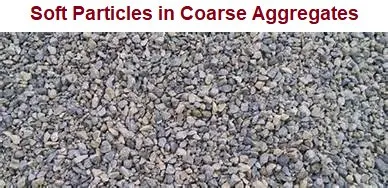How to determine the soft particles in coarse aggregates?
The test is not intended
to identify other types or deleterious materials in aggregates.
 |
| Soft Particles in Coarse Aggregates |
Determination of Soft Particles in Coarse Aggregates as per IS: 2386 Part-2
IS Code for Determination of Soft Particles
in Coarse Aggregates:-
- IS: 2386 (Part-2) 1963, Method of estimation of deleterious materials and organic impurities.
Apparatus Required for Determination of Soft Particles in Coarse Aggregates:-
- A brass rod of 1·6 mm diameter with Rockwell hardness of 65 RHB to 75 RHB inserted into the wood shaft of an ordinary lead pencil.
- IS Sieves of size 50 mm, 40 mm, 25 mm, 20 mm, 12.5 mm and 10 mm.
Sampling
of the Test Specimen:-
Sample
should be available in amounts of 10 % or more:
|
Sieve Size in mm (Square Opening Sieves) |
Sample Weight in gram |
|
Over 10 to 12·5 |
200 |
|
Over 12·5 to 20 |
600 |
|
Over 20 to 25 |
1500 |
|
Over
25 to 40 |
4500 |
|
Over 40 to 50 |
12000 |
Procedure for Determination of Soft Particles in Aggregates:-
- Each particle of aggregates shall be scratched with the brass rod using about 1 kg of pressure.
Particles are considered as soft particles if a groove is made in them without deposition of metal from the brass rod or if the separate particles are detached from the rock mass, during the scratching process.
- Weight and number of
particles of each size of each sample classified as soft in the test (let m₁, m₂, m₃, m₄, m₅ are their weight and n₁, n₂, n₃, n₄, n₅ are numbers).
- Weight and number of particles of each size of each sample tested with the brass rod (let M₁, M₂, M₃, M₄, M₅ are their weight and N₁, N₂, N₃, N₄, N₅ are numbers).
Note:- In
the case of some sandstones, brass fragments may be deposited on hard
individual grains while at the same time separate particles are detached from the
mess due to a weak binding medium. Such
particles are to be considered as soft particles.
Calculation for Soft Particles in Aggregates:-
Formula
for soft particles in coarse aggregates:-

Report for Soft Particles in Aggregates:-
Weighted average percentage of soft particles calculated from the calculated percentage and based on the grading of sample of aggregate received for examination or, preferably, on the average grading of the material from that portion of the supply of which the sample is representative. In these calculations, sizes finer than the 10-mm IS Sieve shall not be included.
|
Thanks for reading this article.
Please, don’t forget to share it. |

